|
|
Post by Franklin1 on Nov 13, 2007 9:43:35 GMT 10
 Year: Year: Unsure, but newspapers under the original lino were dated 1938. Van came from Capel (near Busselton) in WA. Manufacturer: home made Model: n/a Construction material: masonite skin, wooden chassis, part wooden tow-hitch Dimensions: Unknown Weight: Unknown |
|
|
|
Post by Franklin1 on Nov 16, 2007 8:42:28 GMT 10
1936 caravan in Birdwood Motor Museum SA:In May 2007, forum member cobber wrote: "Last year on the way home from the Morgan rally we called into the Birdwood Motor Museum because somebody told me they had a couple of V V's, and so they did. This was after I had looked at ol’36 but not yet bought it. The sight of the van at Birdwood could have been the catalyst that convinced me to buy ol’ 36. So many similarities in their design." 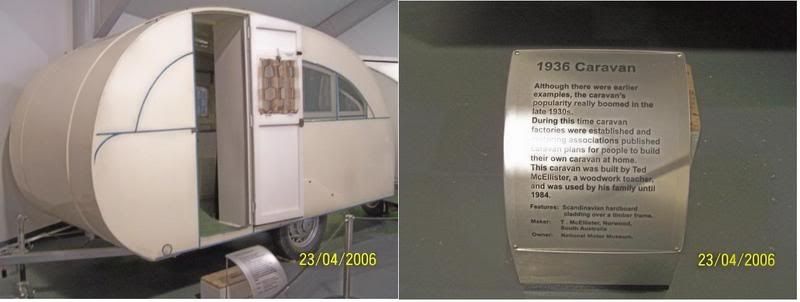 --------------------------------------------------- posted by retro1, Apr 26, 2005, who wrote: These pictures are of the van at the National Motor Museum at Birdwood in South Australia. The first 2 are of a 1936 home-made van... ...The interesting thing about this van is the windows open inwards and the flywire is on the out side. Look at the lantern style roof, it also has no internal lining. 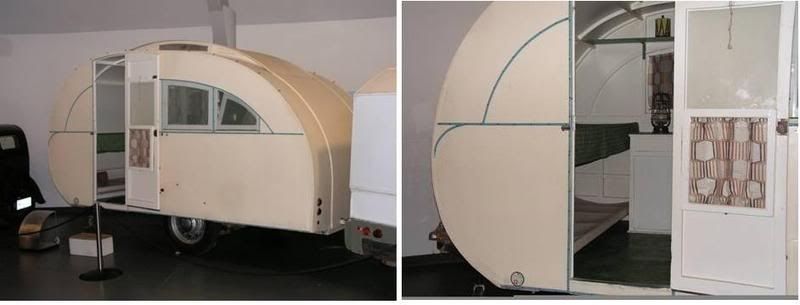
|
|
|
|
Post by Franklin1 on Nov 26, 2007 21:58:17 GMT 10
1938 "Pop-top" caravan: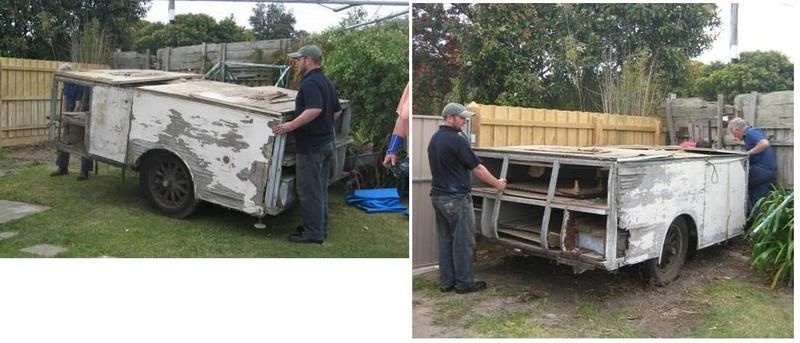 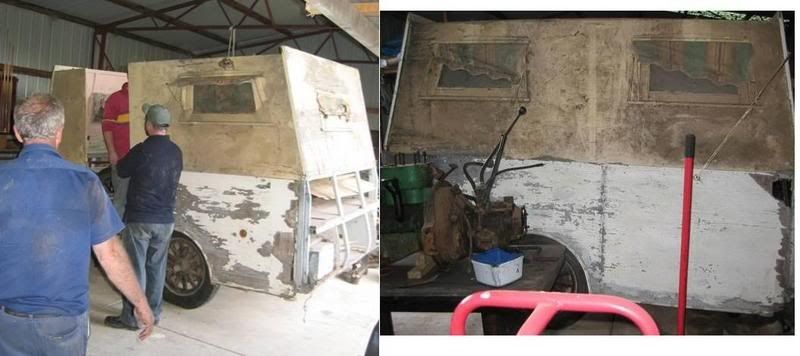 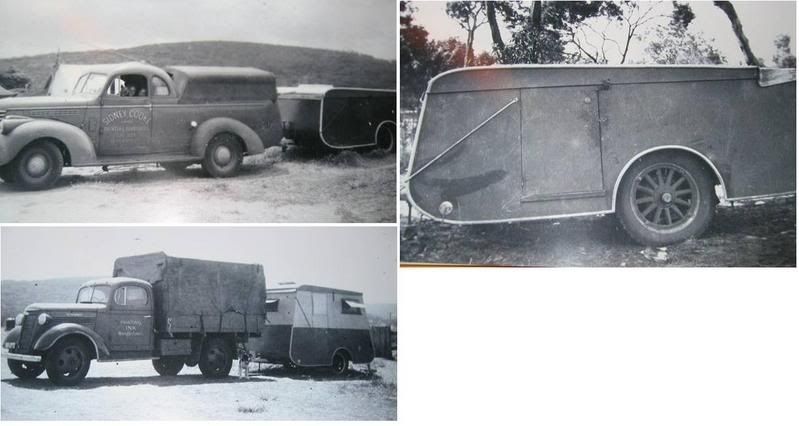 Information Information posted by John, Oct 31, 2006: The history as I know it: The gentleman that I've purchased the van from bought the van from his brother in-law who was the builder who finished it in 1938 and used it on many family weekends in and around Lorne (vic). ...Luckily the previous owner had kept a couple of bits from the original roof which we will use as a template for the replacement. It still has the original glass in all the windows, curtains, blinds and it has two water tanks. From cobber: ...As it was a home made van from the 30's it will be hard to find plans or much information on it. I suspect most vans built in Australia at that period were based on English designs. Back in the 20's "Eccles" experimented with the "collapsible van" idea so who's to say this one you have found isn't copied from that period.
EDITORIAL COMMENT - February 2023: Further photos and information about this collapsible caravan can be found here. Don Ricardo
|
|
|
|
Post by Franklin1 on Dec 27, 2007 18:57:25 GMT 10
1930 caravan at Christies museum, Tocumwal NSW: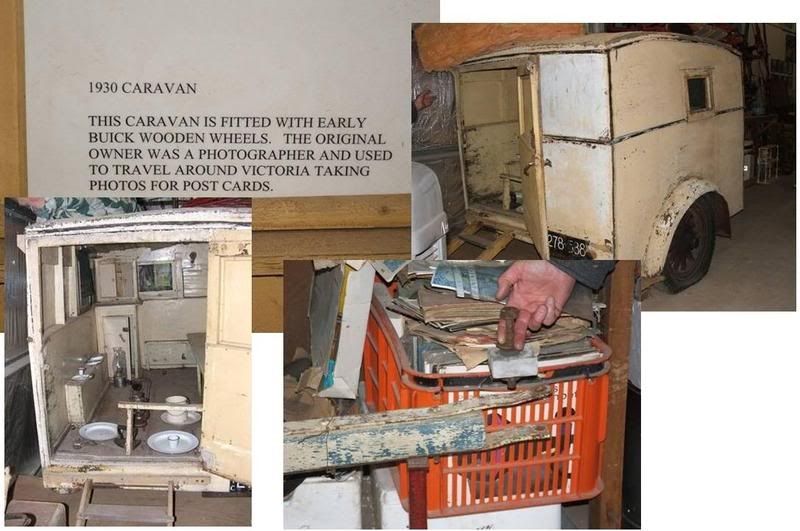 (posted by firefighter, Oct 19, 2007, who wrote:...what a ripper of a museum this is ,4 vintage vans...this museum was at kinglake vic and mr christie retired and moved it to Tocumwal...)
|
|
|
|
Post by cobber on Apr 2, 2008 10:30:26 GMT 10
A caravan / camping scene from the 1930s. I found a book on the way home from Mount Gambier with a couple of photos titled “The last holidays before the second World War”. I have not come across any other photos of actual camping scenes involving caravans in Australia from the 1930s..... does anybody know of others ? The first photo was taken at the RACV Easter rally in 1938 at San Remo Victoria, and the second in 1939 at Lorne Victoria. The question is sometimes asked “did caravans in the 1930s have annexes or awnings fitted”.... the "lantern roof" van in the bottom photo shows a very basic awning. 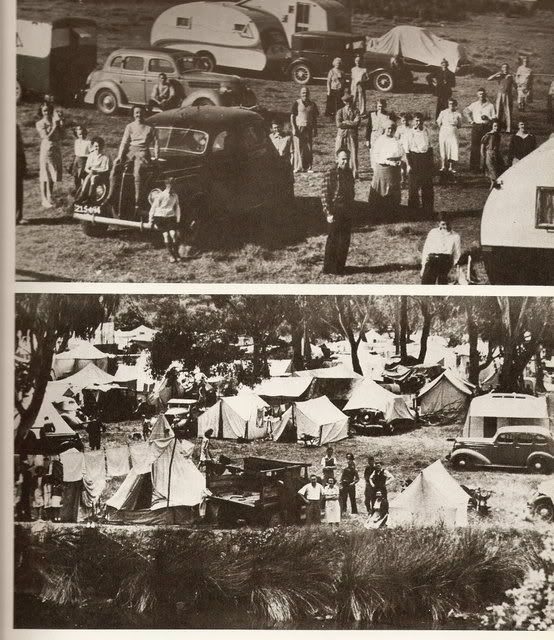 Again another photo from 1937 taken at Moonee Creek camping ground Huskisson shows another awning fitted to a caravan and extending out to cover the car as well. 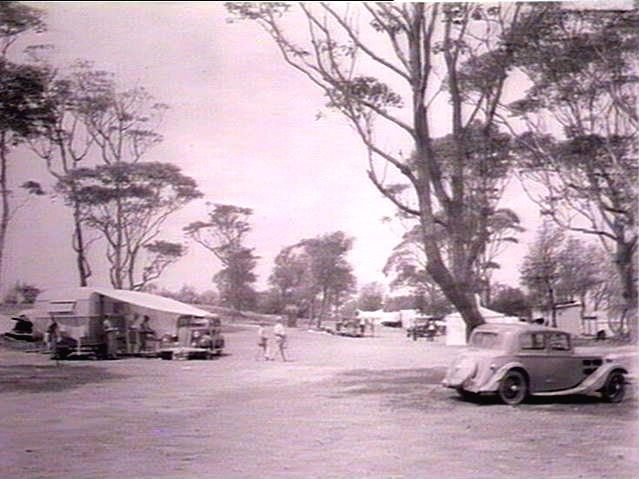 The 'van shown clearly in the San Remo photo I thought looked to be an English “Car Cruiser” but a friend in the UK who knows about these things thinks not ... however it does seem to indicate that back in the 1930s some 'vans were either being brought to Australia from England or being built here based on English designs, many more of them than I expected. An English “Car Cruiser”. 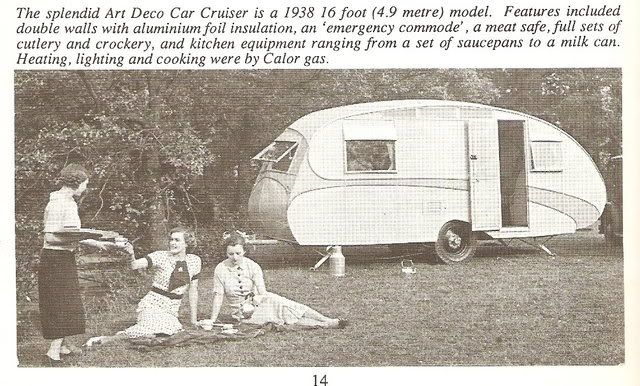 Cobber. |
|
wolf
New Member

Posts: 12 
|
Post by wolf on Jun 3, 2008 21:29:39 GMT 10
Wolfenden Bros produced caravans in Brooklyn, Victoria in the 1930s, and maybe earlier. Does anyone still have one - I would like to see one in the flesh. They used to hire them out too.
|
|
|
|
Post by Don Ricardo on Jun 3, 2008 22:40:46 GMT 10
Hi Wolf,
Welcome to the forum. Nice to hear about another early caravan builder.
I can't find any reference in any of the posts to caravans produced by the Wolfenden Bros, and it's certainly not something I've heard about. Maybe others have?
Can you tell us any more about their caravans? Is one of the Wolfenden vans part of your family history? Does it relate to your forum name of 'Wolf"?
Don Ricardo
|
|
|
|
Post by cobber on Jun 4, 2008 9:06:43 GMT 10
Welcome Wolf,
Thank you muchly for bringing that information to our attention, it is a name associated with caravans we had not heard of.
I consulted the source of all knowledge (Google) and found that Wolfenden Bros started out as manufacturers of woodworking machinery in the early 1920's and, after the second world war, they diversified into all sorts of things including caravans ;D.
This indicates their interest in caravans was post world war 2 but I in no way doubt your assertion they were involved with 'vans pre the war.
Do you have photos or any other details regarding their involvement in the caravan industry?
Regards,
Cobber.
|
|
|
|
Post by firefighter on Jun 4, 2008 11:14:00 GMT 10
|
|
wolf
New Member

Posts: 12 
|
Post by wolf on Jun 4, 2008 11:28:25 GMT 10
The caravans were made pre World War 2, and not continued afterwards as supplies were needed initially for the war effort and then afterwards for recovery. Being primarily an engineering factory manufacturing woodworking machinery, the production focused on machinery as there was a post war building boom on. At some stages machine orders were not filled for 2 years. They had a huge range of machines, many adapted for particular requirements, and my grandfather, being an amateur photographer, left quite a record of probably a hundred or more machines. ( I have no idea how many were made over the decades the business operated.)
Re the Wolfenden Caravans: I have some pamphlet material, a few photos, and a few pieces of other bits and pieces. They were made in a number of sizes ranging from 12' to 16'. If anyone has a copy of a small magazine called The Caravan-eer, dated Dec 1, 1937, they will find a promotional article and advertisement for Wolfende Highway Homes, and also an article on Windmill Car Trailer co. There is also a picture or two in a recently published coffee table size book prepared by Footsray/Yarraville Historical Society - came out in the last year or two.
|
|
|
|
Post by cobber on Jun 4, 2008 11:57:26 GMT 10
|
|
wolf
New Member

Posts: 12 
|
Post by wolf on Jun 4, 2008 22:54:40 GMT 10
Thank you for your replies and interest. I have been doing a bit of digging in my archives, and phoned a couple of older relatives, and have come up with a few extra bits and pieces. It seems the number of vans produced was relatively small. It is thought that production did not start till the second part of the 1930s, and of course was totally interrupted by World War II. The caravan stocks were largely sold off and the building where they were built was used in the production of stuff for the war. That shed later contained some kind of machine for producing/processing flax - a scutching machine. Recuperating blocks for 25lb guns and aircraft cyclinders were two of the items my uncle remembers being prepared for the government. Guesses as to how many caravans were built are around the 20 to 30 mark, so it is not likely that there'll still be one around for me to see. I do remember going for a holiday in one in the early 1960s. The caravans were initially a Saturday afternoon project of my grandfather Ernie, and his young son Stanley. Early models were made out of pine ply and were not waterproof. They had a steel frame and the ply, which was bent, was riveted into place, which required my uncle to be on the inside to place the dolly(?) on the other side of the rivet (not pop rivets), with his father on the outside hammering it in. Later caravans were covered in canvas, glued on to the ply. This did not work. The use of waterproof/marine ply solved this problem, and then the war came and supplies were not available because of navy requirements. Stanley recollects that the 16' van had a shower, but is not sure whether it had a loo as well. (The pamphlet, which covers models from 12' to 15', mentions a folding lavatory seat and tent. The 16' van was perhaps a later model than the pamphlet.) The vans all had big windows front and back, which allowed plenty of air in. This also allowed a clear view for the driver when towing. There was a list of stuff that was included with the vans. I will try to copy/photograph this and post it on site before the end of June. The independent springing (patents pending it says) had adjustable road clearance which enabled floor level to be fixed at any desired hight. There was also a veranda panel. Stanley (uncle) says that the vans even had radio sets which ran on a 12 V battery, with some kind of special power pack to raise the voltage up. (Hope I've got that right.) The steel frame with bent plywood enabled a rounded corner which was rivetted into place. Frank, the youngest brother even built a van where the caravan frame came to a point where the connection ball went on to the car. This reduced air resistance, but only one was made, so I assume the experiment was not considered a success. I am sure I have seen a photo of a van which had a place for a dinghy underneath the van. I will have to hunt through the family photos. A price list dated 30 June, 1938 lists the cheapest van being $175, (12'), and the dearest, a 16 foot van. was $395. Somewhere around 1935-7 the firm exhibited at the Melbourne show. Jean (Aunt) remembers there were only 3 caravan companies there, Don, Windmill, and Wolfenden. I will try to get on to another uncle who also worked there but this will have to wait until after the long weekend as I am going away. Cheers, Wolf
Editorial note: For more info about Wolfenden caravans click here. |
|
wolf
New Member

Posts: 12 
|
Post by wolf on Jun 4, 2008 23:00:47 GMT 10
Correction to message above. The 175 and 395 were in pounds, not dollars. Wolf
|
|
|
|
Post by cobber on Jun 5, 2008 17:33:48 GMT 10
G'day Wolf, The “Windmill” name has been mentioned on the forum previously in regard to some badges a couple of blokes found.... but it was not known if the name referred to a caravan or a caravan park, there are plenty of “Windmill” caravan parks around but now with this information provided by you there is a fair chance the badge was made to be put on a caravan. 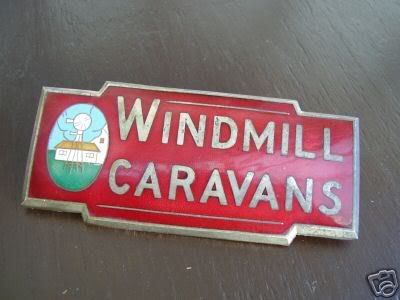 See the discussion here and more info about Windmill caravans here. Cobber. |
|
wolf
New Member

Posts: 12 
|
Post by wolf on Jun 6, 2008 16:38:58 GMT 10
Dear Cobber,
The Windmill Car Trailer Co was at 5 Marion Street, Footscray, started in 1923, building vans in different states of the Commonwealth, owned presumably by Mr G Moreland. I have a bit more information about the Windmill Car Trailer co, and a lot more about Wolfenden caravans, having borrowed quite a bit of primary source material from my brother. Included are 3 old caravan magazines, two from 1930s and one from 1940s. One of the 1930s one is a UK mag, the others are The Caravan-eer. Also have lots of photos. It appears that there were at least 36 vans produced by Wolfenden, and it looks as if the hiring fleet was at least 21, by the numbering on the hiring records. More to come when I have time to look through and sort all the info I now have.
Cheers, Wolf
|
|
|
|
Post by Don Ricardo on Jun 7, 2008 21:55:56 GMT 10
G'day Wolf,
Thanks for telling us some of the story of Wolfenden and Windmill caravans. It's fantastic when somebody such as yourself is able to provide a bit more information about the very early days of caravanning - and caravan manufacture - in Australia. It all adds to the overall picture which is gradually being put together.
I'm really looking forward to seeing some of the photographs and documents you've mentioned. Hopefully you will find the instructions for posting photos that Cobber has referred you to reasonably straightforward, but if you have any trouble I'm sure either one of us will be happy to help you in whatever way we can.
Regards,
Don Ricardo
|
|
|
|
Post by cobber on Jun 24, 2008 21:17:11 GMT 10
An item about “Wolfenden Highway Homes” from “Caravan World” March 2003, page 55. Page 1 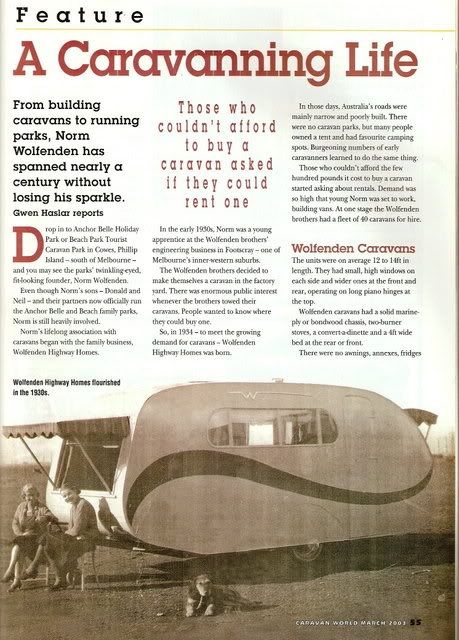 Page 2 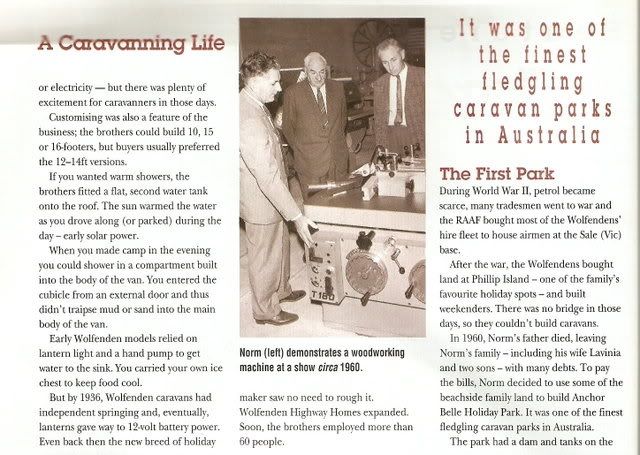 Page 3 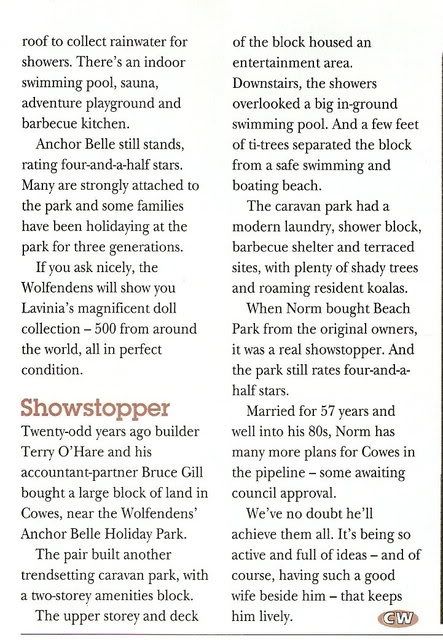 Cobber. |
|
|
|
Post by Don Ricardo on Jun 24, 2008 22:20:32 GMT 10
Hi Cobber,
Great article on the Wolfenden family.
1933/34 was obviously a pretty significant time for the Australian caravan industry:
1933 - First Jennison caravan
1934 - First Wolfenden caravan
1934 - First Don caravan
We haven't got any info on the first Roma in 1928 yet, but we're getting closer.
Don Ricardo
|
|
|
|
Post by firefighter on Jun 24, 2008 23:17:45 GMT 10
    hi cobber you are not going to believe this 4 years ago I stopped in the anchor belle caravan park at cowes for 2 weeks with the car club from bendigo ,you walk out the back gate of the park and across the lane way towards the beach there is a 2 story house that belonged to the father with a very large shed full of antique machinery..... " wolfendons " we had a look in the shed & I never put this together when wolf joined the forum... its just when I read you article it all clicked f/f ;D ;D ;D ;D ;D ;D
|
|
|
|
Post by beetlesbailey on Aug 14, 2008 16:06:33 GMT 10
Back in 77 whilst I was vanning around Australia in a 66 F100 and a 22 ft 1971 Millard, I worked for "iron bar" Tuckey at his Carnarvon 'tourist centre' which was the way he got around the new council law that banned caravan parks within ? miles of the post office.
Any way the council must have told him to improve the park as another travelling carpenter in the park I was in told me of work repairing old vans at the 'tourist centre'.
I wish I had some photos of the vans there as they were all bondwood relics that looked too old to bother with then.
There would have been 20-30 ofthem but we repaired only about 10. The work consisted of erecting a 'safari' roof over each van to keep the water out, then we lined them inside (over the original) with laminated ply and in one case birdseye walnut!
This reminds me of how disgusting some restorations can be.
We also had to put wheels on them all so "in the event of a fire they could be towed out."
What a laugh. If youv'e ever seen a van fire you will know that by the time you hitched up your van, the one beside yours would be a smouldering ruin.
This trip down memory lane reminds me of the empty feeling we got when we passed the remains of a wrecked van on the side of the highway.
An event we came very close to in the Kimberley when the eff truck blew a back tire causing a jacknife at 50 miles an hour which left the Millard jammed against the steel ute canopy on about 45degree angle (that is, the centre of the van hubcap was about 5ft 6in off the ground.
I dont want to go there again let me tell you!
Cheers
Beetles
.
|
|
|
|
Post by cobber on May 5, 2009 19:07:43 GMT 10
|
|
|
|
Post by Don Ricardo on May 9, 2009 14:35:36 GMT 10
G'day Cobber, Interesting photo of the 'REO' caravan. I wonder whether the name 'REO' has anything to do with the REO cars and trucks named after Ransom E Olds? Maybe it was built using some REO mechanical components? I know, I know - you said you didn't know anything about it...just me speculating (again).    Bit of an irony that these days REO is the name of the little teardrop-style caravan built by Roadstar. Just goes to show there's not much new! Don Ricardo |
|
|
|
Post by cobber on May 9, 2009 19:07:52 GMT 10
G'day Don R. The existence of these other “Reo” vehicles does goof up a Google search for information on this “Reo” aye? The source of this photo (John Oxley Library, State Library of Queensland) doesn't actually indicate if the Reo was built.. or only photographed.. in Brisbane. She is a solid looking thing so maybe an American trucking company had something to do with it....none of my English caravan books mention “Reo”, maybe...  if we knew somebody  with an American vintage caravan book.... they might find reference to “Reo” trailers   Cobber. |
|
|
|
Post by Don Ricardo on May 10, 2009 0:03:28 GMT 10
G'day Don R. ...maybe...  if we knew somebody  with an American vintage caravan book.... they might find reference to “Reo” trailers   Cobber. Yeah, that's right Cobber...if we only knew somebody with an American vintage caravan book...there must be somebody    ...thinking, thinking, thinking...who could there be? I'm sure somebody mentioned not so long ago that they had one of those books...now, who was it...? Oh, yes, I know! Cobber maybe we could ask Reddo to look in his bedtime reading book...maybe for a couple of old mates like you and me he might do it? Don Ricardo PS Was that what you meant by being subtle, Cobber?? |
|
Deleted
Deleted Member
Posts: 0
|
Post by Deleted on May 10, 2009 7:22:12 GMT 10
    Request noted.....  "The book" is not a comprehensive list of caravan manufacturers .... more a book on the "Rise and Demise" of the caravaning craze in America from early 20s to the 50s. I have seen "Pearce Arrow " mentioned as a van builder of the era. I believe they built cars as well. Curtiss and another fellow by the name of George Sherman can take the Will do some speed reading and see if i can find if "Reo" gets mentioned.... OBTW..... speed reading for me is a page a day.....  ... stay tuned. Reddo
|
|